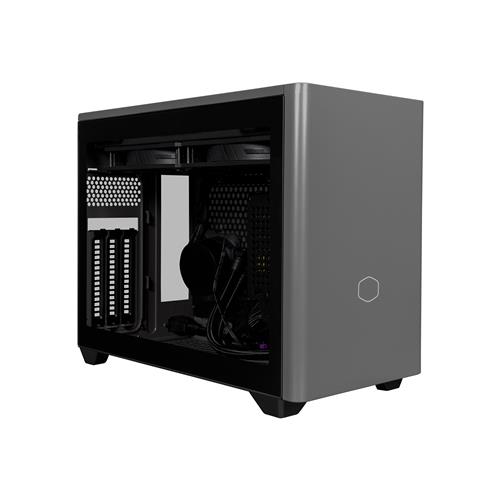

Introduction

Despite higher priced headphones and earphones getting more attention from people, simply because they tend to be out of our reach and thus usually only interactable via reviews, there is no doubt that the budget-friendly in-ear monitors market has never been more competitive than it is now. In fact, we are at the point where you can get a nicely tuned set for $20 or less now, leaving no excuse for brands that try to charge a lot for terribly tuned IEMs. So far, 2024 has seen some compelling releases in this segment, with more to follow in the new year to offer different takes on tuning so you can now try out products, see what tuning works best for you, and then go from there for more expensive offerings if you so wish. Today we look at MOONDROP’s latest affordable IEMs entry, and thanks to SHENZHENAUDIO for providing a review sample to TechPowerUp!

MOONDROP is not new to the ~$20 price range, and I’d argue it was the original Chu which started this race 2.5 years ago. The CHU has since been supplanted by the CHU 2 that brought back the detachable cable, while there was yet another, even less expensive line forming with the MOONDROP Quarks, the Quarks DSP, and now the Quark2—don’t ask me why it’s not Quarks 2. This set costs less than $20, has an integrated DAC with Type-C connector allowing you to connect directly to your phone or laptop without needing an external source, an in-line microphone with volume and media playback controls, and adopts a bullet-style form factor with small shells that insert into the ear canal for good isolation while still being comfortable. Surely this promises to be a product that will interest many of our readers? Let’s put the MOONDROP Quark2 to the test in our review today which begins with a look at the product specifications in the table below.
| MOONDROP Quark2 In-Ear Monitors | |
|---|---|
| Shell: | Plastic/polycarbonate shells |
| Cable: | (Probably) copper conductor with in-line microphone and controls |
| Driver Units: | 7.8 mm LCP dome + flexible suspension diaphragm dynamic driver |
| Frequency Response: | 20 Hz-20 kHz |
| Impedance: | Not provided |
| Sensitivity: | Not provided |
| Cable Length: | 4 ft/1.2 m |
| Warranty: | One year |
Packaging and Accessories
Packaging is on the simpler side for the MOONDROP Quark2, which isn’t surprising given the more value-oriented offering it aims to be. Forget the artwork MOONDROP is known for, we don’t even get a decorative banderole on the small cardboard box. The brand and product names are on the front, with a sticker that has the product specs on it helping seal the box. I still appreciate that MOONDROP managed to include a factory frequency response curve here though. Open the box to see the IEMs pointing inward through a cardboard sheet, with the cable looping through a cutout into the layer beneath. There we see some paperwork in the form of a quick start guide going over the usage and maintenance of these IEMs, in addition to a warranty/QC card and, of course, some female artwork because it’s MOONDROP. The Quark2 comes with no carry case or soft pouch, although we do get some silicone ear tips in sizes S/M/L. These are generic single-flange tips that are certainly worth trying out, although you may wish to consider aftermarket tips if you do not get a decent fit and/or seal with them.
Closer Look
The MOONDROP Quark2 has a permanently attached cable similar to the Quarks DSP we saw before, with a Type-C digital connector headed to the source. There is a DAC underneath the branded plastic housing to convert the digital audio signal to analog in addition to adding in any EQ filters that MOONDROP may deem fit—the Quark2 is also a DSP set, for those wondering. There is very little information otherwise provided about the cable, so I can only speculate that underneath the basic silicone sleeving is a pure copper conductor. We then see a branded gray circular splitter without any cable cinch, and then comes a bonus feature in the form on an in-line microphone with tactile volume/media playback/call controls on the split wire headed to the right channel itself. Both channels terminate on the underside of the IEM shells where L/R markings help indicate the left and right channels, respectively.
The MOONDROP Quark2 reminds me a lot of the Quarks DSP in that both are tiny IEMs compared to the average set sold today. The newer Quark2 even looks similar, except for the back where there seems to be an injection molded plastic casing housing the driver and the rest of the shell. This becomes the de facto faceplate thus, down to the many holes cut in it. The circular form factor also allows for a similarly shaped dynamic driver to be placed inside, although we then see a clear section made of polycarbonate and the actual driver through it. The front section has damping materials to act as an acoustic filter to tame the treble response of the set, and this is also the IEM nozzle, with a 6.15 mm diameter at the very end, and 5.6 mm before. There is a metal mesh placed towards the end to prevent contaminants from entering the acoustic chamber. These are clearly bullet-style IEMs which fit straight into the ear canal rather than having the cable go over and around the ears, thus the lack of a cable cinch isn’t as big a deal as the lack of a shirt clip to minimize microphonics from the IEM and microphone cable in use. Installing the provided ear tips is simple enough given the hard stop provided where the nozzle meets the wider part of the shells, as seen above. Using the Quark2 is as simple as plugging the Type-C connector into the equivalent port on a compatible phone or computer. My phone immediately recognized the set as earphones ready to go, and we can also see how the IEMs with the cable work cohesively in this gray color scheme. MOONDROP also confirms the DAC used here is a new chip, which bodes well compared to the issues faced by the DUSK. It’s capable of decoding up to PCM 32-bit/384 kHz playback, which is plenty for anyone using this set with a phone or laptop.
Fit and Audio Performance
Seen above is the right side of the MOONDROP Quark2 installed in an anthropomorphic pinna that does well in showing my own experience with these. I have average-sized ears, and found the provided size M silicone tips to work best. Given the Quark2 is a straight-insertion set of in-ear monitors, it would be a fair assumption that it will fit just about anyone, as long as the 6.15 mm nozzle width at the very end is not a dealbreaker. The smaller size and bullet-shaped shells directly enter the ear canal and the cable falls straight down meaning you have more leeway in positioning the IEMs in your ears than with the more common approach of the cable going around the back of the ear and being a support point at the top. The Quark2 is held in place just by the fit achieved in your ears then, which makes having a good seal all the more critical. These weigh ~4.5 g per side to where I had zero physical fatigue even for longer periods of use. I still recommend finding a cable clip to secure the cable to your shirt, if only to help with keeping the in-line microphone fixed in place when you want to use it while also reducing any potential cable microphonics.
The MOONDROP Quark2 uses a single dynamic driver per side to no surprise, knowing these are budget IEMs. The compact shells mean a micro driver is used, with a 7.8 mm liquid crystalline polymer (LCP) dome + flexible suspension diaphragm and neodymium N52 magnets driving it back and forth. The diaphragm is associated with a copper-clad aluminium wire (CCAW) voice coil. The acoustic chamber has a special cavity design meant to make the most of the driver assembly that feeds straight into the ear canals, after having gone through the acoustic filter in the closed front cavity anyway. All this comes together to make for a set of IEMs that MOONDROP does not even provide the impedance and sensitivity values for, albeit it’s a non-factor here given the integrated DAC/amp in the cable that powers the drivers in addition to doing some onboard DSP work too. The in-line microphone is also automatically recognized, so you actually end up with a headset and not just headphones with the Quark2.


Testing was done similar to all other IEMs including the MOONDROP x Crinacle DUSK. Seen above is the measured frequency response for both channels of the Quark2 plotted against my personal IEM target, which can be inspected further here if interested. I have also added in the average response against the Harman 2019v2 in-ear target given this seems to be clearly what MOONDROP was aiming for with the Quark2. I’ll also mention that the channel balance on my sample is excellent by all metrics irrespective of pricing, let alone for a more affordable set such as this one.
I am not the biggest fan of the Harman target for IEMs as I’ve mentioned several times before. In fact, I am quite tired of all the IEMs still being released that are tuned to match this target, again at various price points. Of course I understand that this is one of the most research-backed earphone targets based on user preferences across different backgrounds. It ultimately recognizes that the average consumer likes a fairly substantial bass and treble presence—usually matching each other, and this is why the V-shaped tuning is also popular with mainstream IEMs and headphones. While the Harman in-ear target helps keep the mids be cleaner compared to a more traditional V-shaped sound, I personally think it has too much bass and too much ear gain. There’s also the part where the mid-bass feels tucked in, allowing for some lost impact for the likes of bass guitars and drums. The Quark2 goes for a Harman-like tuning, but has a few tiny changes worth noting. The sub-bass is slightly lower, and the mid-bass tuck is less pronounced. Likewise, the ear gain is also less than a pure Harman-tuned set to where vocals don’t come off as shouty in the ears. The mids in general also feel more prominent, aiding instrument classes too. A deeper fit can affect how the mid-treble sounds to you (length modes), but overall I’m content with the treble extension and general lack of timbre issues. In this price range, tonality is by far the most important since you really can’t expect a lot of subjective goodness. The Quark2 isn’t going to win any detail retrieval or dynamic range awards, let alone precise imaging and a wide soundstage, perhaps. I will give it credit for being punchier than I thought it would be though, and of course the tuning will favor sub-bass impact too. More importantly, there was no background hiss I noticed with the Quarks DSP or even the DUSK, although some of this could just be the driver not resolving everything to the same extent the DUSK does. The in-line mic is okay in a pinch, but won’t replace even an inexpensive lapel mic, although it’s more about the convenience of having it on the same cable as the IEMs.

For context, I have the MOONDROP Quark2 compared here against some other affordable IEMs I’ve tested, including of course the previous entry in the lineup which was the Quarks DSP. There’s a lot in common here, yet the Quarks DSP can be more comfortable with its even smaller shells and nozzle. It goes for a bassier tuning, although comes off more distorted compared to the Quark2 that also manages to hit harder in the mid-bass. The Chu 2 costs slightly more and offers a detachable 2-pin cable, which also means you need your own source, and you lose out on the in-line mic w/controls. It’s warmer sounding than the Quark2 and has more treble presence too, which makes it feel more detailed to an extent. But there’s really very little else differentiating the Chu and Quark lines from MOONDROP now, so I don’t think we’ll see a Chu 3 at this rate. The TangZu Audio Wan’Er S.G comes in a variety of colors and finishes now and is my personal pick from a tuning point of view too. It also goes for a detachable cable, and sounds better to my ears with most vocals and instruments being reproduced more accurately. The Truthear HOLA was another option before it got discontinued, although there is the newer GATE which aims to pick up where the HOLA left, I’ll see if I have time to cover it separately. The Quark2 isn’t for everyone, yet it’s a good starting point for people to try out a more balanced tuning compared to V-shaped sets prevalent in this price range. The likes of KZ dominate the sub $20 market too, and they tend to overwhelm consumer choice by releasing dozens of IEMs that all seem and sound very similar. I can’t recommend KZ in general owing to the poor marketing and customer service I’ve seen from the brand multiple times. As it stands, the MOONDROP Quark2 costs $16.99 from authorized retailers including SHENZHENAUDIO, as of the time of this article. It’s not going to hurt most wallets and even a basic phone dongle sometimes costs more than that to where you do get a lot more bang for your buck here.






























